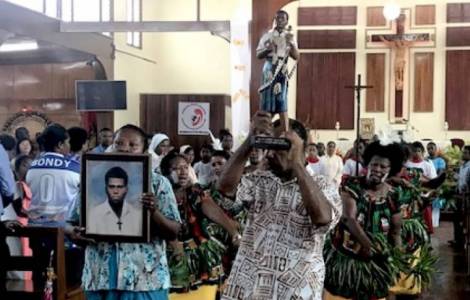
Vatican City (Agenzia Fides) - Pope Francis has authorized the Dicastery for the Causes of Saints to publish the decree for the canonization of catechist and martyr Peter Tor Rot, who will thus become the first Saint from Papua New Guinea. The date will be set during the Consistory (still to be scheduled) announced by the Pope a month ago while he was being treated for bilateral pneumonia at Gemelli Hospital.
The requests and prayers of the Church of Papua New Guinea, which asked the Pope a few months ago during his visit to Asia and Oceania to intervene in the canonization process of the catechist and martyr (see Fides, 6/9/2024), have been heard.
Born in Rakunai in 1912, Peter belonged to the Tolai community, who live in the easternmost part of the island. The exact date of his birth and baptism is unknown, as the documents were confiscated by the Japanese police during World War II. What is certain is that he grew up in a large family and was primarily educated by his father, a village chief. After receiving his First Communion, probably between 1922 and 1926, he served as an altar boy, moved by a deep devotion to the Eucharist.
From 1930, he attended Saint Paul's Catechist Training College in Taluligap and returned to his village three years later to actively exercise his ministry as a catechist. He also devoted himself to works of charity, with a particular focus on the poor, the sick, and orphans. At the age of 23, he married Paula La Varpit and became the father of three children.
At the outbreak of World War II, the Japanese occupied Papua New Guinea and imprisoned all missionaries, but this did not initially hinder his pastoral work. Peter To Rot made every effort not to abandon the Christian community, continuing his catechetical activities and preparing couples for the sacrament of marriage.
When the occupiers forbade him from continuing his work, he carried it out secretly and with extreme caution so as not to endanger the lives of the faithful, knowing full well that this decision could cost him his life.
During the occupation, he opposed the reintroduction of polygamy, which the Japanese had allowed to curry favor with the local tribes, and thus also turned against his older brother. The latter denounced him to the police, and for these reasons, he was arrested in 1945 and sentenced to two months in prison. During his imprisonment, he received only visits from his mother, his wife, and his children. He was treated more harshly than the other prisoners and died of poisoning in prison in July 1945.
Peter To Rot was beatified by Saint John Paul II on January 17, 1995, in Port Moresby, the capital of Papua New Guinea.
On March 18, 2024, the bishops of Papua New Guinea and the Solomon Islands requested that the miracle be waived on the path to Peter To Rot's canonization. At the same time, they noted that while there is ample evidence, it is very difficult to document the required miracle because there are few hospitals capable of providing the scientific documentation necessary to prove a supposed miraculous healing, and because the culture of the local population is largely based on oral communication, making it difficult to document any miracles in writing.
In addition, up to 820 dialects are spoken in the State, so few people are able to write in correct, understandable English. For these reasons, the request was granted, and on March 22, 2024, the Dicastery was authorized to conduct the special process with a dispensation of miracles for the canonization of Peter To Rot.
This is a process by which the Pope, after due examination, recognizes a cult that has already existed for some time, without waiting for the recognition of a miracle. It differs from formal beatifications and canonizations, for which the Church provides for a regular investigation and the corresponding miracle. Furthermore, the Pope can always make special decisions. Pope Francis did this in the case of John XXIII, who was canonized based on his decades-long worldwide reputation for holiness, without a second miracle being recognized. Benedict XVI also applied an extraordinary process with regard to John Paul II, whose canonization process was initiated a few weeks after his death, without waiting the required five years.
As for To Rot, after his beatification, his reputation for holiness grew considerably and extended to all the dioceses of Papua New Guinea, as well as to the neighboring Solomon Islands and Australia. Hundreds of works about him have been published on behalf of churches, institutions, and groups associated with his memory.
There are also many acts of grace attributed to his intercession, collected after his beatification, when his person became better known. His reputation for holiness is widespread today. (F.B.) (Agenzia Fides, 31/3/2025)